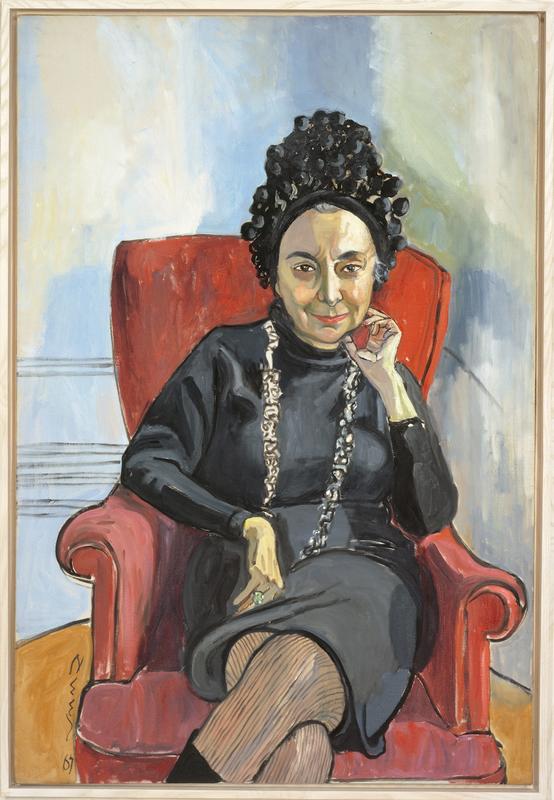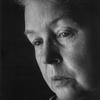More about Charlotte Willard

Contributor
Immortalized in this quirky painting, art critic Charlotte Willard stares at us with a gaze that she would usually have directed at the very artwork she sits in.
In this case, however, it is the American artist Alice Neel who allows herself a critical look, not only at her subject’s persona, but also at social conventions, elitism, and the patriarchy - basically all those things in the world that needed some improvement (and still do).
Charlotte Willard is only one of many portraits that define Neel’s unique artistic activism. Actually, according to Neel, they are not even portraits. For her, the mere term is elitist; she preferred to call her paintings ‘pictures of people.’ That, however, feels too simple of a description for paintings that go far beyond a mere depiction. With her unassuming and non-judgmental gaze, Neel brought her subjects’ genuine identity onto canvas, turning her into a self-declared ‘collector of souls.'
So, which souls apart from Charlotte Willard does her collection include? American lawyer Bella Abzug, art historian Linda Nochlin, poet Frank O’Hara, and a bare-chested and bandaged Andy Warhol two years after he had been shot, along with many other public figures. Sounds like a high-society life that Neel has led, right? Well, not quite. It took her three decades before she received the recognition she deserved. Largely thanks to the momentum of the women's rights movement, her career took off in the late 1960s
Until then, according to Neel, her paintings had been too tough for people to grasp. And that comes to no surprise. Neel focused on everyday people like family and friends, and more controversially, on her immigrant neighbors in Spanish Harlem, including working class individuals, the socially disadvantaged, impoverished, drug addicted and those ravaged by diseases, and, with Neel being a feminist, of course pregnant women and mothers. The indiscriminate inclusion of anyone in society is the beauty of Neel’s work, which embraces humanity and gives a face to all walks of life, with the aim of challenging social constructs.
Neel’s unbiased approach is reflected in her bohemian lifestyle. Yet, most of her life, Neel struggled as an artist and single mother - circumstances that have imaginably contributed to her ability to emphasize and connect with her subjects when ‘collecting their souls’. As Neel explained “I do not pose my sitters. I do not deliberate and then concoct… Before painting, when I talk to the person, they unconsciously assume their most characteristic pose, which in a way involves all their character and social standing – what the world has done to them and their retaliation.”
Her subject Charlotte Willard was a keen admirer of Neel’s intimate psychological explorations, stating "Even fully clothed, her sitters appear naked before us in their vulnerability, their bewilderment, their aggressions, their self-concern, their resignation. . . The fact that she records their presence is proof of her compassion."
Willard must have been quite pleased to be painted by Neel. With her fancy headdress, chunky jewelry and elegant black attire posing comfortably on a throne-like chair, she is the subject of one of Neel’s more glamorous depictions, which in itself is a fine example of the artist’s feminist vision - a compelling, independent and self-confident woman in an era women were not granted much power.
Sources
- Adams, Katherine H. and Keene, Michael L. Women, Art, and the New Deal. (Jefferson, North Carolina: McFarland & Company Inc., 2016.) p.48
- “Alice Neel’s Feminist Portraits: Women Artists, Writers, Activistis and Intellectuals.” (Exhibition Catalogue). Samuel Dorsky Museum of Art (SDMA) & State University of New York at New Paltz. October 15 - November 23, 2003. https://www.newpaltz.edu/media/museum/exhibitions/aliceneelcatalogue-1…
- “Alice Neel.” The Art Story. Accessed on August 10, 2022. https://www.theartstory.org/artist/neel-alice/
- Als, Hilton. “Alice Neel’s Portraits of Difference.” The New Yorker. April 19, 2021. https://www.newyorker.com/magazine/2021/04/26/alice-neels-portraits-of-…
- Bilyeu, Suzanne. “Alice Neel, Painting Portraits: Capturing Souls.” Art Scholastic. March 2001. Vol. 31, No.5.
- “Exhibitions: Alice Neel and Pictures of People.” De Young Museum. March 03, 2022. https://deyoung.famsf.org/alice-neel-and-pictures-people
- Hope, Henry R. “Alice Neel: Portraits of an Era.” Art Journal. Vol. 38, No. 4 (Summer, 1979), pp. 273-281. https://www.jstor.org/stable/776378?seq=4#metadata_info_tab_contents
- “Human Dignity and Bioethics.” Essays Commissioned by the President’s Council on Bioethics. March 2008.
- Kracov, Julie. “Artist Alice Neel, a Collector of Souls.” CBS News. July 25, 2021. https://www.cbsnews.com/news/artist-alice-neel-a-collector-of-souls/
- O’Sullivan, Michael. “Painting the Person, Not the Pose.” The Washington Post. November 04, 2005. https://www.washingtonpost.com/archive/lifestyle/2005/11/04/painting-th…
- Southern, Hannah. “Five Fast Facts: Alice Neel.” National Museum of Women in the Arts. October 02, 2019. https://nmwa.org/blog/5-fast-facts/5-fast-facts-alice-neel/#:~:text=In%….











